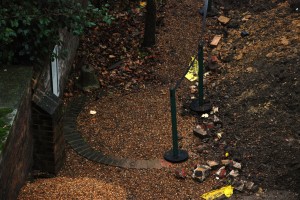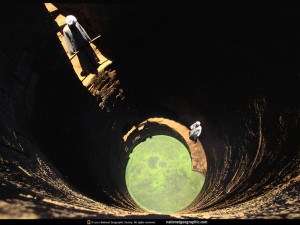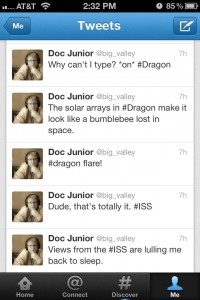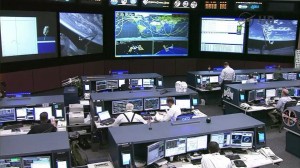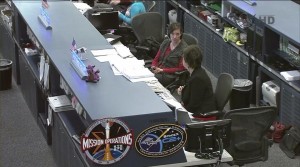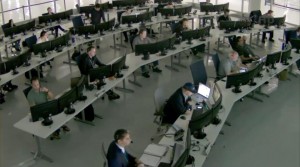You should be impressed. It’s two o’clock in the morning and I’m writing a blog post. Without my glasses. Proof of landing above, more images and explanations to follow tomorrow.
Wheels Down
6 08 2012Comments : Comments Off on Wheels Down
Categories : Instruments, Mars Science Laboratory, NASA, News
MSL Raw Images
5 08 2012
This image was taken by Front Hazcam: Left A (FHAZ_LEFT_A) onboard NASA’s Mars rover Curiosity on Sol 0 (2012-08-06 06:23:34 UTC). Image Credit: NASA/JPL-Caltech
Future Mars Science Laboratory raw images will be collected at http://mars.jpl.nasa.gov/msl/multimedia/raw/. Check back for the early images returned by Curiosity!
ETA: Try http://mars.jpl.nasa.gov/msl/multimedia/images/ if the raw images aren’t working in your browser. If you’re using Chrome, try clearing your cache. If you still can’t load the raw images, try IE.
Comments : Comments Off on MSL Raw Images
Categories : Instruments, Mars Science Laboratory, NASA, News
NuSTAR
2 08 2012While I was off doing other things in June, NASA successfully launched the Nuclear Spectroscopic Telescope Array (NuSTAR) from a carrier aircraft somewhere over the Pacific Ocean. I mention this now because earlier this week, JPL announced that NuSTAR passed its Post-Launch Assessment Review. This means that although it has been observing X-ray sources for the past few weeks, the instrument has been cleared officially to enter the “science operations phase” of its two-year mission.
Here’s mission description from the Cal Tech website:
“NuSTAR will open a new window on the Universe by being the first satellite to focus high-energy X-rays into sharp images. NuSTAR’s high-energy X-rays eyes will see with more than 100 times the sensitivity of previous missions that have operated in this part of the electromagnetic spectrum, and with 10 times better resolution. NuSTAR will shed light on some of the hottest, densest, and most energetic objects in the universe.”
Sounds cool, all that sharpness and sensitivity, but what does it all mean? What will those super sharp images tell us?
The magic words: black holes and stellar explosions.
NuSTAR’s super optics permit the observations of active galaxies with black holes at their core (much like the Fermi Large Area Telescope and the Chandra X-Ray Observatory). Some of this is just a more complex form of census taking, looking closely at the center of our own galaxy and surveying the black holes and collapsed stars. On top of that is the added objective of mapping the composition of the youngest supernova. The hope is by identifying and locating all the materials in a supernova, we will come to a better understanding of the explosive process and how it creates the elements that make up our universe.
The third layer of the science objectives has to do with “relativistic jets.”[1] I find relativistic jets both easy and incredibly difficult to understand. On one hand, a relativistic jet is just a super intense steam of plasma (partially ionized gas) jetting out of the center of active galaxies/black holes/neutron stars. On the other hand, what the heck? You might remember the Internet buzz about this time last summer, when a black hole was observed “devouring” a star. Astronomers stumbled on that example by sheer luck: the Swift satellite was in the right place at the right time—in the path of the star’s remains in the form of a relativistic jet. It’s not so much that we don’t know these jets exist, but the theory of how they exist is still being polished by physicists. NuSTAR observations should help with that.
To keep track of NuSTAR’s discoveries, visit the News and Updates section of the mission site.
——
[1] If you’re wondering why they use the word “relativistic,” it’s because the particles move at almost the speed of light (0.99995c!).
Comments : Comments Off on NuSTAR
Categories : Instruments, NASA, Observatories
Wallpaper Wednesday
1 08 2012You didn’t forget about me, did you? I’m about to land on Mars!
Mars Landing: 5-6 August 2012
10:31 pm Pacific, 5 August
11:31 pm Mountain, 5 August
12:31 am Central, 6 August
01:31 am Eastern, 6 August
05:31 am Universal, 6 August
Watch it live online at:
mars.jpl.nasa.gov
nasa.gov (NASA TV)
jpl.nasa.gov (Ustream)
Click on the image to download the JPL MSL wallpaper.
Comments : Comments Off on Wallpaper Wednesday
Categories : Instruments, Mars Science Laboratory, News, Wallpaper
Greenwich Observatory
30 07 2012I’ve yet to talk about my own research on this site, mostly because I’d like this to remain a ‘fun’ space, related to—but not dominated—by my real work. I’ve had an article on the relationship between Empire and the first Astronomer Royal under review for most of the past year, making me even more reluctant to write here about the Greenwich Observatory (RGO) for fear of scooping/contradicting/boring myself. But the observatory has been on my mind this week, so I decided to throw up a few photos I took during a winter visit.
Once you climb to the top of Observatory Hill (because of course you’re going to want to walk up there from Greenwich), you enter the observatory through an iron gate. To the right of the gate is the 24-hour Shepherd Clock, designed in 1852. Originally, the clock displayed astronomical time, but now it shows Greenwich Mean Time (of course). It may or may not reflect your time of arrival accurately, since it doesn’t keep track of British Summer Time. The Shepherd Clock is a slave clock, meaning that it’s controlled by a master clock elsewhere in the observatory.[1] Flamsteed would have been a lot less frustrated if the clock had existed during his tenure at the observatory. On the other hand, he had two Thomas Tompion clocks at hand, making him one of the most time-rich observers in London at the time.
If there’s one thing visitors know about the RGO, it’s that a brightly colored “time ball” drops every day at 13:00 GMT (BST in the summer). In theory, boaters on the Thames can synchronize their timepieces by the daily ball drop. In practice, boaters stopped looking to the observatory for this soon after the Great War, when the radio started providing time pips.
This unassuming patch of gravel is one of my favorite parts of the observatory. Once upon a time, this was the site of the well telescope. For many years, the existence of a well telescope at Greenwich was a matter of debate: did Flamsteed actually sink a shaft, install spiral stairs, and make nightly observations from the floor of the well? P.S. Laurie argued for the existence of a hole in which Flamsteed placed a telescope with a 87.5 foot focal length (seriously!).[1] In theory (again), Flamsteed used the instrument to observe gamma Draconis as it crossed the zenith, with the intent of compiling enough observations to calculate the star’s annual parallax. In practice, the well telescope was a failure. For one thing, Flamsteed had to lie on his back to use it. There’s no comfort to be found in lying on one’s back in the middle of the night at the bottom of the well. For another thing, the lens was chipped and cloudy and of little use to the astronomer.[2]
If I described all of the nifty things to see at the RGO (the time galleries, the camera obscura, the 28-inch refractor), you’d be reading this page for another several hours. You won’t be bored, and the planetarium and the Astronomy Centre have plenty of interactive exhibits to entertain the children. I’m not a child, but I spent quite a bit of time crashing imaginary spacecraft the last time I was in the Astronomy Centre. But take heed:
At the moment, the observatory is closed to the public. Why? Take a look at the view from the north side of Flamsteed House.
If you’ve been watching the 2012 Olympics, you probably recognize that Neoclassical building. The garden facade of the Queen’s House is getting quite a bit of air time, serving as a backdrop to the dressage and other equestrian events. Behind the Queen’s House and the National Maritime Museum, across the Thames, loom the Docklands. Just to the left of the Queen’s House, above the colonnade, you can see the line of the river and the embankment of the Isle of Dogs. If you cross to the Isle of Dogs and travel north past the skyscrapers (the building with the pyramidal top is the Canary Wharf Tower), across the A11, you will soon find yourself in Olympic Park.
The good news—if you’re in town for the duration of the Olympics, you need only hang on until August 4, when the RGO opens again to the public. Have a nice visit and say hello to the shell of Herschel’s telescope for me.
————————-
[1] It’s no longer controlled by a clock, but by a new quartz mechanism inside the building. The original master isn’t in working condition, but you can see it in the time galleries all the same.
[2] P. S. Laurie, “Flamsteed’s Well,” The Observatory 76 (1956): 24-5.
[2] A. Hunter and E. G. Martin, “The Flamsteed 90-Foot Lens,” The Observatory 76 )1956) 25-6.
Comments : Comments Off on Greenwich Observatory
Categories : Instruments, News, Observatories
Wallpaper Wednesday
4 07 2012There are a few things you shouldn’t do during a full moon. You should avoid criminal activity—your neighbors will probably recognize you in the bright light and if you end up in the emergency room, you’ll get inadequate care because of overcrowding (even if statistical analyses indicate there’s no relationship between the lunar cycle and emergency room chaos, do you really want to take the chance?). You should also avoid going to bed with the blinds open—your neighbors will have a good view of your after-dark activities and even if you’re intending to sleep, the moonlight will keep you awake by shining in your eyes (I proved this one last night). You should avoid looking at a magnified view of a full moon—your neighbors may wander over to ask what you’re observing after you set up the telescope, but they’ll be less than impressed when they go home with an after-image of the moon burned into their retinas (been there, done that, only with Mars).
What you can do during a full moon: naked eye observing. Sky and Telescope has some tips on studying the maria, craters, and volcanic patches on the lunar surface. Or, you can take some of Deirdre Kelleghan‘s advice and try your hand at Sketching the Moon (visit the publisher’s website). Another option: Study the lunar calendar so you know the date of the next Blue Moon (I’ll save you some trouble—it’s August 31, 2012). Or spend the evening looking through NASA’s archive of moon photos.
One thing you should definitely do is click on the image above to download the wallpaper of a Blue Moon fronted by NASA’s RASCAL. This wallpaper perfectly captures my ambivalence about some of NASA’s research (past and present). As much as I’d love to sink more money into programs like MSL and the Hubble Telescope, I can’t forget NASA’s close connection with military research. A beautiful Blue Moon shining behind a modified UH-60 Black Hawk reminds me of that association, but more importantly, it demonstrates how easy it is to distract me with shiny objects and moon rocks. I should be paying more attention to what’s going on outside the public eye.
Happy Independence Day.
Comments : Comments Off on Wallpaper Wednesday
Categories : Instruments, NASA, Wallpaper
Wallpaper Wednesday
27 06 2012A few months ago, I provided the link to kuriositas’ 10 Spectacular Radio Telescopes Around the World. I’m providing the link again so you can read about the Nobeyama Radio Observatory, home to the 45-meter telescope shown in the image above. I’d tell you more about it myself, but I have a pounding headache and just don’t feel like it.
Click on the image to download the wallpaper.
Comments : Comments Off on Wallpaper Wednesday
Categories : Instruments, Observatories, Telescopes, Wallpaper
Wallpaper Wednesday
20 06 2012Today’s post celebrates the arrival of the June solstice. The image above shows a measuring well in Aswan (Syene), Egypt. Aswan is situated such that at high noon on the solstice, the sun appears directly overhead. If you stand a stick straight up in a pile of sand, you won’t see its shadow. If you lean over a well, you won’t cast a shadow on the water because the sun is directly overhead. If you repeated this behavior the next day, and the day after that, and so on, you would see slivers of shadow appear and gradually grow larger as the days passed.
It was just this observation that inspired Eratosthenes’ legendary calculation of the Earth’s circumference. Eratosthenes was already in the habit of measuring the shadows cast in his hometown of Alexandria at noon on the solstice. When he noticed the lack of shadow in the southern city of Syene at the same time of day/year, he realized he could use the angle of the shadow in Alexandria to calculate the angle between the two cities as measured from Earth’s center. A few applications of geometry later, he arrived at a decent estimate of Earth’s circumference.
Click on the image above to download the wallpaper. Unfortunately, it’s only available in two sizes. To make up for that deficit, I’m giving you something even better: a link to Carl Sagan’s explanation of Eratosthenes’ work.
Comments : Comments Off on Wallpaper Wednesday
Categories : Instruments, Wallpaper
Wallpaper Wednesday
6 06 2012
SDO's Ultra-high Definition View of 2012 Venus Transit --- Path Sequence. Image credit: NASA/SDO/AIA
Was there any doubt that I’d be looking for a wallpaper featuring yesterday’s Transit of Venus? I’m happy to report that we didn’t have to rely on SDO images (as spectacular as they are!) to view it. We had mostly clear skies, warm evening temperatures, and lots of viewing equipment. I had my doubts as to whether we’d be able to view it with the naked eye—that is, the naked eye with protection—but it was easy to see through eclipse glasses. I used a solar projector made with a pair of binoculars. That was a last-minute project, but it made beautiful images, complete with cloud cover, sun spots, and Venus. We attended a public viewing event for part of the evening, courtesy of the DNR, Stonebelt Stargazers, and the Indiana University Astronomy Club, so we also had some excellent views through 8″ and 10″ telescopes. You can see a few photographs, including one from the solar projector showing Venus against the backdrop of the Sun, on my flickr site.
Click on the image to download today’s wallpaper.
Comments : Comments Off on Wallpaper Wednesday
Categories : Instruments, NASA, News, Wallpaper
Dragon in the Morning
24 05 2012We did get up to watch the ISS + Dragon capsule flyover at five o’clock this morning. The pair came up in the west, reached a maximum altitude of 36 degrees, and set in the north-northeast. Dragon is a pretty subtle beast–I’m not sure we would’ve been able to spot it in the slide into astronomical dawn if we hadn’t known to follow the path of the ISS. It doesn’t come close to the magnitude of the Space Shuttle. Once Catherine broke out the binoculars, however, we had a great view. Since Dragon trailed the ISS by only two degrees or so, both spacecraft fit in the magnified field of view.
I had every intention of going back to bed after the four-minute flyover, but of course, I had to tweet about it and so got sucked into watching NASA’s coverage of the Dragon fly-under of the ISS.
That little gray dot at vertical center, left of horizontal center, is Dragon, just making its presence known. Just after I clicked the button to capture this screen shot, I saw a Dragon flare. Flares are fairly common with iridium satellites (you can use Heavens Above to track them), but I wasn’t expecting to see one this morning, even via the computer screen. You can see my excitement on twitter:
I snapped a photo of the bumblebee, but it’s even more apparent in NASA’s video of this morning’s ISS fly under. I wish they would’ve picked up the video earlier so you could hear Astronaut Don Petit’s call: “I’m looking at Dragon right now.”
Today was about testing the system. While the fly-under brought Dragon within 2.5 km of the ISS—in other words, exactly where it was supposed to be at the time—more exciting was the moment the capsule’s strobe light powered on in response to a command issued from the ISS. This confirms that the ISS astronauts can communicate with the capsule, a necessity when guiding it into its dock on Friday, May 25, 2012.
There was a lot of downtime in this morning’s broadcast. As you can see by my twitter feed, the images from the ISS were soothing and soporific. Initially, so were the images of Mission Control, but the longer I watched, the more fascinating those silent rooms seemed to me. Take a look at this screen capture of Mission Control at Houston:
A bunch of guys in long-sleeved dress shirts and ties, staring a very large arrays of computer monitors. From the above vantage point, those desks look completely useless, all that dead space behind the monitors. But when you look backward across the room…
…you can see that the desks operate as shelves for the people sitting in the rows just in front of them. Nice adaptation. Still, Mission Control looks like what you’d expect: desks, ties but no suit jackets (except that one guy!), staring at screens, looking as if they’re hidden in a bunker. The women in the room are the exception to the dress code. Today, the voice of Mission Control was wearing red:
You might also have noticed that NASA has tossed a few toy dragons around the room. Even so, nothing in this room really leaps out as “Not NASA.” NASA tends to update, never fully overhaul, their aesthetics and spatial arrangements. This point became very clear whenever SpaceX Mission Control in Hawthorne, California, came on the screen.
That is not a room put together by NASA. That looks like every IT conference or training program I’ve ever attended, and I’ve attended a lot. I see a suit, but I also see the ubiquitous polo shirt and button-up short-sleeve dress shirt. And I swear that’s a baseball cap down front. I see light coming in through floor-to-ceiling glazing (check out Ian O’Neill’s launch day photo of the same space). No rigid rows—hierarchy is subtly undermined by those bent tables. We’re looking at an entirely different space culture than the one cultivated by NASA. A quick-and-dirty reading of the two Mission Controls could lead to the conclusion that private industry embraces transparent operations, while the NASA (the U.S. Government) still operates in Cold War super secrecy. I know this isn’t exactly true, but that’s the message the architecture is sending out. If I was NASA, and I wanted to be part of the future of space exploration, I’d do something about the contrast between the two images.
Comments : Comments Off on Dragon in the Morning
Categories : Instruments, NASA, SpaceX, Video






